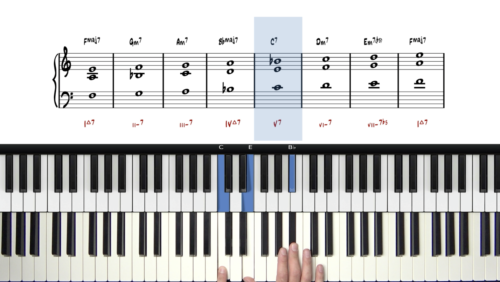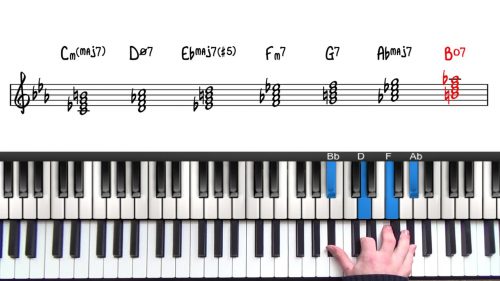Exploring the B Section of "Over the Rainbow"
Welcome to our lesson on the B section, or bridge, of "Over the Rainbow." In this session, we’ll delve into the harmonic and melodic elements of bars 17 to 24, building upon the concepts we’ve covered in the A sections. By the end of this lesson, you’ll have a deeper understanding of the common chord progressions and voicing techniques used in this iconic jazz standard.
"Over The Rainbow" B Section Harmony
The B section introduces no new chords, so we’ll focus on reinforcing the harmony using familiar 7th chords. We start with an E♭maj7 chord, followed by a 2-5 progression (F-7 to B♭7), and a 3-6-2-5 progression (G-7, C7, F-7, B♭7). These 2 progressions are foundational in jazz, and we’ll play them using two-handed spread voicings to achieve a fuller, more connected sound.
Voicing Techniques & Principles
The melody in the B section differs significantly from the A sections, providing a fresh perspective on the harmonic structure. We’ll begin by playing the melody with root position 7th chords in the left hand, and then explore alternative voicings that create a more balanced and smooth sound.
To avoid overlapping hands, we’ll distribute the chord tones between both hands, placing the root and fifth in the left hand and the third and seventh in the right. This technique, known as two-handed spread voicings, is essential for creating a cohesive and flowing performance.
Practice Tips
-
Visualize the Harmony: Focus on seeing the 7ths falling to 3rds within the 2-5-1 progressions. This mental visualization will help solidify the chord progressions in your mind.
-
Explore Alternative Voicings: Experiment with placing the root and 5th in different octaves to see how it affects the overall sound and depth of the chord.
-
Pace Yourself: Play through the B section slowly, allowing your hands to adjust to the different voicing options. This will help you build muscle memory to navigate the chord changes with confidence and fluidity.
- Melodic Variation: Remember that in jazz, the melody is flexible. Feel free to make subtle changes to better match your interpretation of the song.






